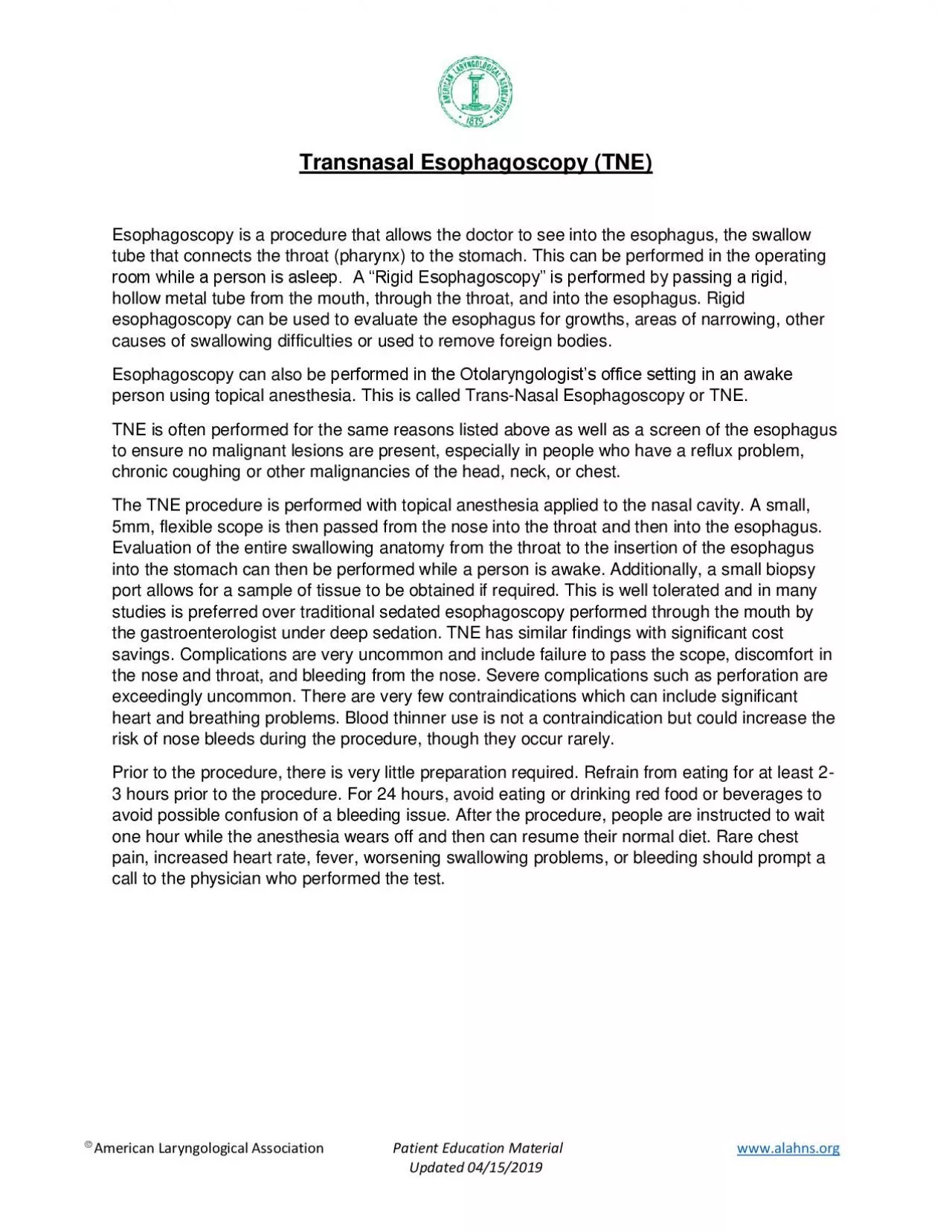

Patient Education Material wwwalahnsorg Updated 04152019 Transnasal Esophagoscopy TNE Esophagoscopy is a procedure that allows the doctor to see into the esophagus the swallow tube that c ID: 953609
Download Pdf The PPT/PDF document "American Laryngological Association" is the property of its rightful owner. Permission is granted to download and print the materials on this web site for personal, non-commercial use only, and to display it on your personal computer provided you do not modify the materials and that you retain all copyright notices contained in the materials. By downloading content from our website, you accept the terms of this agreement.
American Laryngological Association Patient Education Material www.alahns.org Updated 04/15/2019 Transnasal Esophagoscopy (TNE) Esophagoscopy is a procedure that allows the doctor to see into the esophagus, the swallow tube that connects the throat (pharynx) to the stomach. This can be performed in the operating room while a person is asleep. A “Rigid Esophagoscopy” is performed by passing a rigid, hollow metal tube from the mouth, through the throat, and into the esophagus. Rigid esophagoscopy can be used to evaluate the esophag us for growths, areas of narrowing, other causes of swallowing difficulties or used to remove foreign bodies. E sophagoscopy can also be performed in the Otolaryngologist’s office setting in an awake person using topical anesthesia . This is called Trans - N as al Esophagoscopy or TNE. TNE is often performed for the same reasons listed above as well as a screen of the esophagus to ensure no malignant lesions are present, especially in people who have a reflux problem , chronic coughing or other malignanc ies of the head, neck, or chest. The TNE procedure is performed with topical anesthesia applied to the nasal cavity. A small, 5mm, flexible scope is then passed from the nose into the throat and then into the esophagus. Evaluation of the entire swallowing anatomy fr om the throat to the insertion of the esophagus into the stomach can then be performed while a person is awake. Additionally, a small biopsy port allows for a sample of tissue to be obtained if required. This is well tolerated and in many studies is prefer red over traditional sedated esophagoscopy performed through the mouth by the gastroenterologist under deep sedation. TNE has similar findings with significant cost savings. Complications are very uncommon and include failure to pass the scope, discomfort in the nose and throat, and bleeding from the nose. Severe complications such as perforation are exceedingly uncommon. There are very few contraindications which can include significant heart and breathing problems. Blood thinner use is not a contraindicat ion but could increase the risk of nose bleeds during the procedure, though they occur rarely. Prior to the procedure, there is very little preparation required. Refrain from eating for at least 2 - 3 hours prior to the procedure. For 24 hours, avoid eating or drinking red food or beverages to avoid possible confusion of a bleeding issue. After the procedure, people are instructed to wait one hour while the anesthesia wears off and then can resume their normal diet. Rare chest pain, increased heart rate, feve r, worsening swallowing problems, or bleeding should prompt a call to the physician who performed the test.